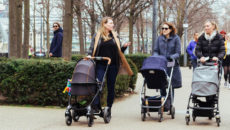Adoptive parents often find that the most helpful counsel they receive comes not from books or “experts,” but from fellow parents who have walked the same path. In this special series, we compile words of wisdom from the Adoptive Families community, to illuminate the range of experiences within the adoption world and offer advice you won’t find elsewhere. In this first installment, parents discuss the complexities of open adoption.
“It’s Not Co-parenting” – Easing Initial Fears About Openness
“Remember that you’re doing what’s best for your child. Having an open adoption means he or she never has to wonder. That sense of abandonment is not there.”
“Open adoption can mean so many different things. It doesn’t necessarily mean you are inviting each other over for holiday dinners. It can be as simple as regular emails or texts. And, in some cases, you may realize that you want more contact as time goes on.”
“As my daughter forms her identity during the teen years, she needs and craves information about her biological background, her birth story, and what she has in common with her birth family—and her birth mom is the one who can provide that. I can’t say that it is easy or uncomplicated, but it seems clear to me (and evidence supports this) that knowledge is power and is a much healthier psychological way to go for our beloved kids.”
“It’s not co-parenting. It is hard at first, but it will even out. And having more people in your child’s life who can offer unconditional love? Priceless.”
“As with any other relationship, honesty and communication are key. Know that all of you, at some point, will have hurt feelings or say the wrong thing; address these in a mature fashion and you can work it out. Remember that the arrangement is not about you, and it’s not about the biological family—it is about the person being adopted.”
“Let’s Put It in Writing” – Post-Adoption Contact Agreements
“Our adoption agency drafted and sent us a ‘Written Understanding Between Adoptive Parents and Birth Parent Regarding Formal Visitation.’ [These may also be referred to as a PACA, or post-adoption contact agreement, MOU, or memorandum of understanding, open adoption agreement or contract, or contact agreement.] It outlined the first visit in detail—when, where, how long—and the frequency of visits thereafter. It specifically stated that we would go to them as long as they lived within 200 miles of the city of birth. If that changed, visits would occur at or near our city of residence. This agreement was not legally binding, but helped with their concerns that we might not stick to our word once we had our daughter.”
“I would spell out the minimum level of contact you would be comfortable with, knowing you can always go over this. I feel that’s better than not meeting the agreement’s expectations.”
“Why Me?” – Explaining Birth Siblings Who Were Not Adopted
“My daughter has older and younger birth siblings, and struggled to understand why she was the only one placed for adoption. I explained to her that every family has its own set of difficulties and challenges, which change over time, and that the adults have to make a choice about every pregnancy based on where they are in life at that time. I added that, in our case, it would be difficult for us to adopt another baby right now because of what we have going on in our lives.”
“Both of my kids have siblings who were not placed for adoption. It’s just their normal. My son, who’s 11 now, has younger siblings. Each time his birth mom had a new child, we’d just tell him, and then we’d talk. Be open about what you know, let your child feel and say whatever he needs to, and know that this will not be a one-time conversation.”
When Birth Parents Struggle with Addiction or Other Instabilities
“I took awhile, but I did come to peace with the fact that my child’s birth mother doesn’t have her life together and nothing that I can do will help that. We just keep trying to visit with her. Sometimes it happens and sometimes it doesn’t.”
“I have a suggestion for visits that is a little sneaky but helpful sometimes. You and your partner drive separate cars to the meeting place. The parent driving your child should be a few minutes late. The early spouse should talk to and interact with the birth mother to see if she is clean and rational, then call the late spouse. If mom is good, say, ‘Hey, we are here. How long will you be? If she is not in a good place and you are uncomfortable allowing her around your child, say, “Hey, are you stuck somewhere? Oh, you are. OK, I will reschedule with ____. Then offer her a ride home.”
“Keep the Door Open” – When Contact Fades
“If you stop hearing back from the birth mother, keep trying—if not directly, then through your agency. You don’t want to have to explain to your child that you gave up on the connection with her birth family.”
“Sometimes adoptive parents misunderstand and think the birth mother ‘needs space,’ when really the birth moms are walking on eggshells and just afraid to ask for more contact.”
“There have been several times when our son’s birth mother did not show up for visits. Since the second time that happened, I haven’t told him beforehand about visits, so that he wouldn’t go through the same sadness and disappointment.”
“When you talk with your child, be careful to frame it as his birth mother is having some ‘difficult, grown-up issues, and we may not hear from her for some time,’ and emphasize that it has nothing to do with him.”
“Open Adoption Is…” – Concluding Perspectives on Openness
“I believe our job as adoptive parents is to keep all the points in the adoption triad connected. The way I see it, the child’s needs are top priority, the birth parents are second priority, and, realistically, we are last priority. The only way I would ever risk upsetting my daughter’s birth mom would be if I were doing so to protect my daughter.”
“When you’re not sure how to respond to a request from your child’s birth mother or birth family member, step back and think about how you would reply if the person were an in-law or another relative.”
“If you’re not sure how your child’s birth mother would feel about something, like opening up contact with her parents or sending her a card on Mother’s Day…ask her. Open communication is healthy.”
“Our daughter is 100 percent our daughter. She is also a biological daughter, granddaughter, and niece to her birth family. In the spirit of celebrating these connections, I’ve put my feelings of ‘I’m the Real Mom’ aside time and time again—especially in the early years, when all of this was so new and it was sometimes challenging to accept that our daughter has and always will have two maternal figures.”


